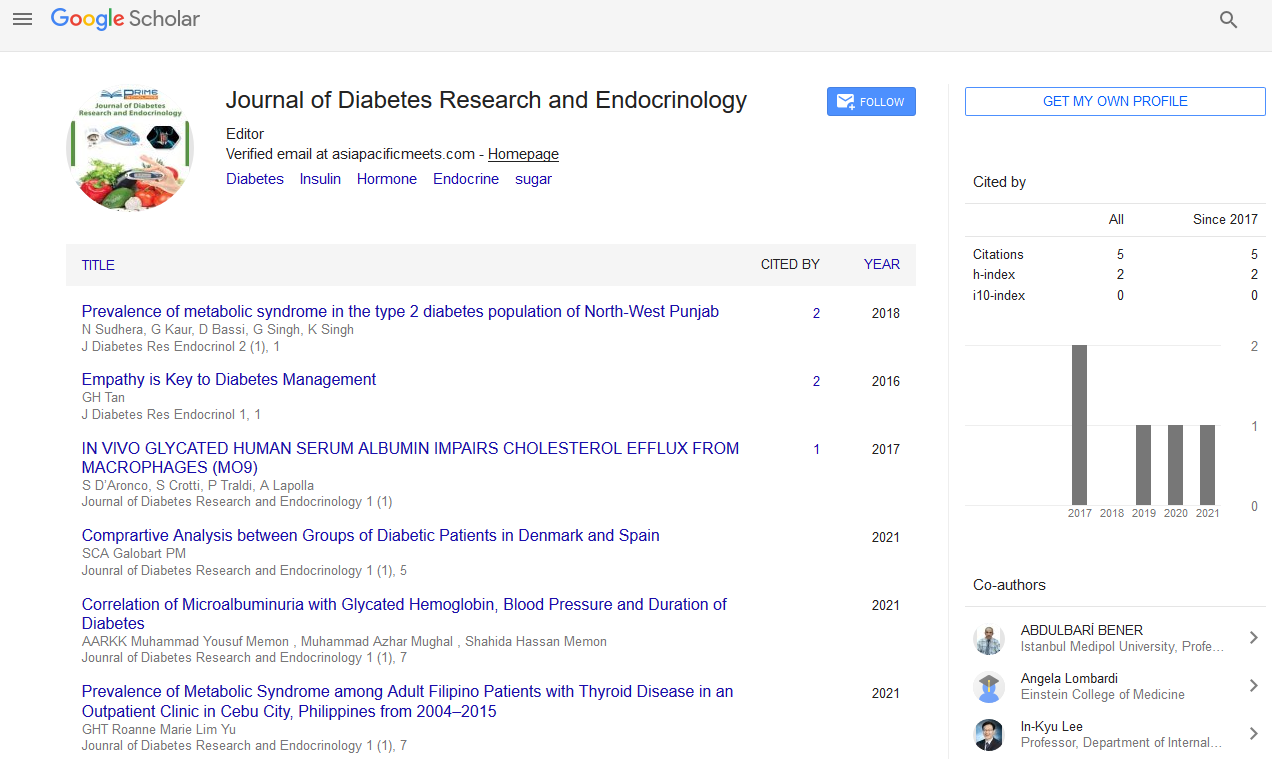Opinion - (2024) Volume 8, Issue 1
The Role of Incretion Mimetic in Diabetes Therapy
Ava Wright*
Department of Endocrinology, Chichester University, UK
*Correspondence:
Ava Wright,
Department of Endocrinology, Chichester University,
UK,
Email:
Received: 28-Feb-2024, Manuscript No. IPJDRE-24-20063;
Editor assigned: 01-Mar-2024, Pre QC No. IPJDRE-24-20063 (PQ);
Reviewed: 15-Mar-2024, QC No. IPJDRE-24-20063;
Revised: 20-Mar-2024, Manuscript No. IPJDRE-24-20063 (R);
Published:
27-Mar-2024, DOI: 10.36648/ipjdre.08.01.07
Introduction
Incretion mimetic, a class of medications used in the treatment
of type 2 diabetes mellitus (T2DM), have emerged as valuable
therapeutic agents due to their unique mechanism of action
and favourable effects on glycaemic control and weight
management. This article explores the role of incretion
mimetic in diabetes therapy, highlighting their mechanisms
of action, clinical efficacy, and potential benefits for patients.
Incretion hormones, such as glucagon-like peptide-1 (GLP-1)
and glucose-dependent insulin tropic polypeptide (GIP), are
released by the gut in response to food intake. They play a
crucial role in regulating glucose homeostasis by stimulating
insulin secretion, inhibiting glucagon release, delaying gastric
emptying, and promoting satiety. Incretion mimetic are
synthetic analogy of endogenous incretion hormones designed
to mimic their effects on glucose metabolism. The two main
classes of incretion mimetic are GLP-1 receptor agonists (GLP-
1RAs) and dipeptidyl peptidase-4 (DPP-4) inhibitors. GLP-1RAs
bind to and activate GLP-1 receptors on pancreatic beta cells,
stimulating insulin secretion in a glucose-dependent manner.
Description
They also suppress glucagon secretion, slow gastric emptying,
and promote satiety, leading to improved glycaemic control and
weight loss. DPP-4 inhibitors block the enzymatic degradation
of endogenous GLP-1 and GIP, thereby increasing their
circulating levels. This results in enhanced insulin secretion
and suppression of glucagon release, leading to improved
glucose control. Incretion mimetic have been shown to
significantly reduce haemoglobin A1c (HbA1c) levels, a marker
of long-term glycaemic control, in patients with T2DM. Their
glucose-lowering effects are comparable to or even superior
to other antidiabetic medications, such as sulfonylureas and
thiazolidinedione’s. GLP-1RAs are associated with weight loss
in patients with T2DM, making them particularly attractive for
individuals who are overweight or obese. The weight loss effect
is thought to be mediated by reduced appetite, decreased
food intake, and inhibition of gastric emptying. Some GLP-1RAs
have demonstrated cardiovascular benefits beyond glycaemic
control, including reductions in cardiovascular events, such as
myocardial infarction, stroke, and cardiovascular death. These
cardiovascular benefits are attributed to their favourable
effects on blood pressure, lipid profiles, and endothelial
function. Emerging evidence suggests that GLP-1RAs may
exert protective effects on the kidneys, including reductions
in albuminuria and preservation of renal function. These Reno
protective effects are thought to be mediated by improvements
in glomerular hemodynamic, reduction in inflammation, and
attenuation of oxidative stress. Incretion mimetic are generally
well-tolerated, with a low risk of hypoglycaemia when used
as monotherapy or in combination with other antidiabetic
medications. Common adverse effects include gastrointestinal
symptoms, such as nausea, vomiting, and diarrhoea, which are
usually transient and diminish over time. Incretion mimetic are
recommended as second-line therapy for patients with T2DM
who fail to achieve glycaemic targets with lifestyle modifications
and metformin monotherapy. They are particularly suitable for
individuals who are overweight or obese and those at risk of
cardiovascular disease.
Conclusion
Regular monitoring of glycaemic parameters, body weight,
blood pressure, renal function, and adverse effects is essential
to assess treatment response and ensure safety. Incretion
mimetic represent a valuable addition to the armamentarium
of antidiabetic medications, offering unique benefits for
patients with T2DM. Their favourable effects on glycaemic
control, weight management, cardiovascular health, and renal
protection make them an attractive option for personalized
diabetes therapy. However, considerations regarding patient
selection, administration, and monitoring are important in
optimizing their use in clinical practice. As research continues to
elucidate their long-term efficacy and safety profile, incretion
mimetic are poised to play an increasingly prominent role in
diabetes management.
Citation: Wright A (2024) The Role of Incretion Mimetic in Diabetes Therapy. J Diab Res Endocrinol. 8:07.
Copyright: © 2024 Wright A. This is an open-access article distributed under the terms of the Creative Commons Attribution License, which permits unrestricted use, distribution, and reproduction in any medium, provided the original author and source are credited.

